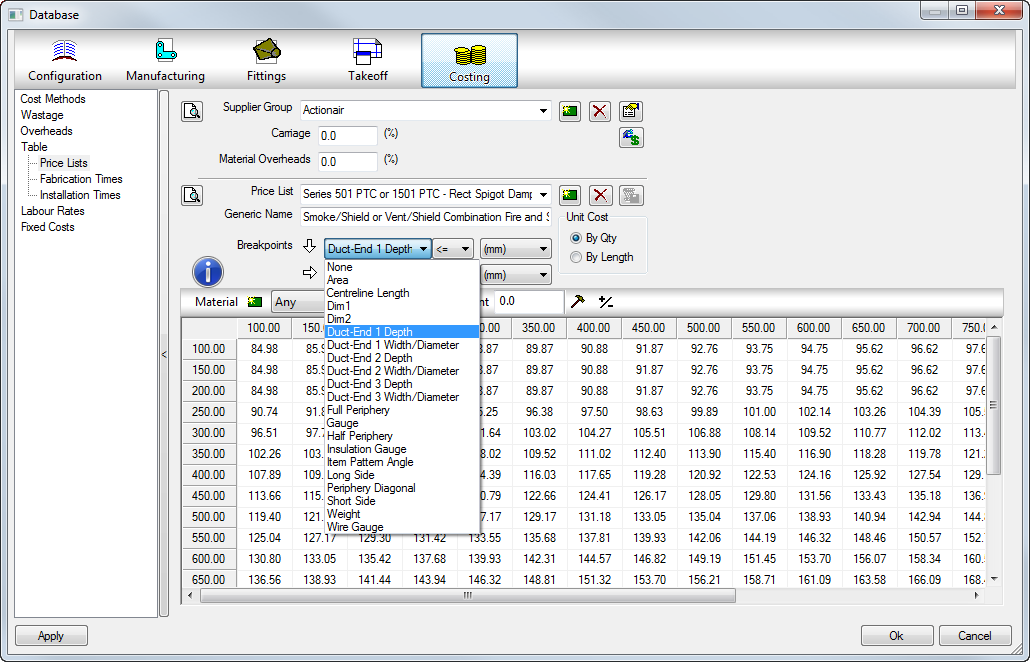Breakpoint Style Price Lists
Price List that have a Breakpoint style. Also known as a matrix lookup table which relies on a value based selection at takeoff in order to allocate a price.
There are multiple methods of setup and can be customized to suit the required item being priced.

Breakpoint Price lists are setup and assigned to items the same way as product based price lists but rather than using code based lookup, these types of price lists can use variant value based lookup.
The above screen shot shows the drop-down menu for the Arrow referencing VERTICAL. This means that the data going down the left side of the table will be based on the Duct End 1 Depth. (The items first ends Depth). The user has the option to reference the table across the to the HORIZONTAL in addition to going VERTICAL, for example Width, if additional requirement is to allocate the price for the Width of the item.
Example of a price of Damper shown above. 700x600 damper price would be £158.34. Width across 700, Depth down 600 = £158.34 based on the Duct End Width/Diameter 1 HORIZONTAL and Duct End 1 Depth VERTICAL assignment of breakpoint.
These tables can be setup to suit the requirements of the item being taken off. The tables can also be used for importing external spreadsheet data for common items such as damper prices or Plant equipment items. See Importing Price Lists Help Topic.
Breakpoint types
Breakpoint types are used to dictate what fields of the item are going to be used for allocating a price. The following types are listed below to help identify how each type is used.
Area: Based on a unit of area (Square meter, inch, foot) reference. Units of measurement set in the units drop-down next to the breakpoint selection.
Centerline Length: Based on an items length through the center including extensions. Units of measurement set in the units drop-down next to the breakpoint selection.
Dim 1 and Dim 2: First couple of dimensions the items uses at takeoff.
Duct End 1 Depth: References the 1st ends (C1 End) Depth of the item.
Duct End 1 Width/Diameter: References the 1st ends (C1 End) Width of the item or the Diameter if Round based.
Duct End 2/3 Depth: References the 2nd or 3rd Depth End, for example used when Reducing Tee pieces could be obtained from the 3rd End.
Duct End 2/3 Width/Diameter: References the 2nd or 3rd Width End, for example used when Reducing Tee pieces could be obtained from the 3rd End.
Full Periphery: References the Width + Depth + Width + Depth as a size based breakpoint. Width 500mm x Depth 500mm duct would be 2000mm in Full Periphery.
Gauge: References the items thickness (Gauge). 0.8, 1.0, 1.2 etc.
Half Periphery: Width + Depth is referenced. 500mmx500mm would equate to 1000mm Half Periphery.
Insulation Gauge: Insulation gauge reference for isolating particular thicknesses of insulation
Item Pattern Angle: Reference of Angle of the item. Typical values could be set to 15, 30, 45, 60 , 75, 90 and then prices added to the cells for each. The items angle at takeoff will allow automatic selection of the price entered into these fields.
Long Side: Items being taken off that have this price list assigned will reference against their Longest side for pricing. 600x400 duct would use the 600 side to lookup values for price.
Periphery Diagonal: Diagonal corner to corner measurement can be used as the reference for price.
Short Side: Smallest side reference can be used to price 600x400 duct would use the 400 side as the lookup to price.
Weight: Using this type allows entry of weights and then price against each weight can be assigned to the values. The units of measurement are selected next to the breakpoint drop-down.
Wire Gauge: Alternative method for pricing against thickness. 22, 24, 26 etc wire gauges.
On selection of type, there is a LESS THAN or EQUAL TO symbol to allow price information to apply prices if they are LESS THAN or EQUAL to the breakpoint values. If using the EQUAL TO symbol alone then unless the items matches for example the breakpoint type by SIZE, then a "no price found" will be applied to the item. It is sometimes good practice to use the LESS THAN or EQUAL TO selections to ensure the item obtains a price.
Unit Cost
Breakpoint tables can be configured to cost per item quantity (meaning the items cost will be the actual value entered in the price cell) or per Length meaning a per meter cost. Per meter prices should be used on any length based items such as Straight, Pipe, Cable or Flex.